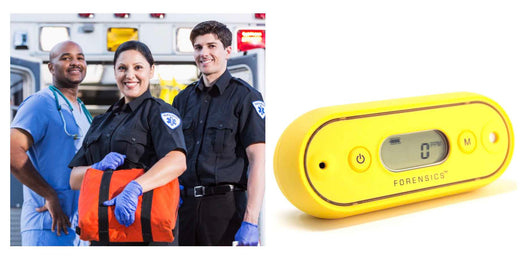Emergency medical services (EMS), emergency medical technicians (EMT), ambulance drivers, use carbon monoxide detectors to protect themselves from CO gas when entering a incident situation. To ensure safe entry into affected areas, first responders must use gas detection devices, such as portable CO meters, as CO is tasteless and odorless. Gas-powered appliances and machinery, including stoves, heaters, and vehicles, can produce lethal amounts of CO that accumulate in homes, offices, or business locations. Carbon monoxide monitors are the only solution to safeguard first responders from CO exposure. It is crucial that EMS always carry a CO monitor when responding to emergencies, as it allows them to detect and assess the presence of this dangerous gas, ensuring their own safety while helping others.
Pros |
Cons |
|
✅ Carbon monoxide detectors save first responders from unintentional CO gas exposure ✅ Carbon monoxide detectors provide visual and audible alarms ✅ Carbon monoxide detectors warn EMS when dangerous levels of carbon monoxide are present in an area they are responding ✅ Some states and counties require EMS to carry CO meters for protection from unintentional carbon monoxide gas exposure |
⛔ Home CO detectors are not appropriate for EMS since they trigger at 70 ppm (too high and not sensitive enough) ⛔ Many carbon monoxide detectors are not waterproof and may not be able to endure harsh outdoor environments. ⛔ CO meters for EMS all require regular calibration and maintenance to assure operation |
Best Carbon Monoxide Detector for First Responders?
Some of the best CO detectors for EMS are:
- Forensics Detectors Waterproof CO Detector
- Sensorcon Waterproof Carbon Monoxide Detector
- Testo Carbon Monoxide Meter
- BW Honeywell Carbon Monoxide Meter
Why Do First Responders Need a CO alarm?
First responders, such as firefighters, paramedics, and police officers, need carbon monoxide (CO) alarms for several important reasons:
-
Detection of Invisible Danger: Carbon monoxide is an odorless, colorless, and tasteless gas, making it impossible to detect without proper equipment. First responders entering environments where CO might be present, such as fire scenes, residential or commercial buildings with gas leaks or faulty appliances, require CO alarms to alert them to the presence of this hazardous gas.
-
Personal Safety: First responders' safety is paramount during rescue operations. CO alarms enable them to recognize the presence of carbon monoxide, thereby preventing accidental poisoning which can occur quickly and without warning.
-
Rescue Operations: During rescue operations, especially in confined spaces or buildings with potential gas leaks, it's essential to know the levels of carbon monoxide to conduct operations safely. High CO levels can indicate the need for additional protective equipment or alternative rescue methods.
-
Public Safety: By detecting CO levels, first responders can also ensure the safety of civilians. They can evacuate people from hazardous areas and prevent them from entering dangerous zones.
-
Investigative Tool: CO alarms can also aid in investigations, helping to identify the source of carbon monoxide leaks. This is important for preventing future incidents and ensuring public safety.
CO Detector Requirements for First Responders?
When choosing a CO detector for EMS, it is best the CO meter:
- can detect low levels of carbon monoxide and alarm at low levels (between 9 to 50ppm) to provide early and fast alarming
- is dust resistant, water resistant to endure various weather and environmental conditions
- is battery operated and can be calibrated, to allow for flexible EMS operation
- is small and light, to not be a burden to EMS personnel
- should include three alarm modes: LED light, Buzzer sound and Vibration. These modes are important to help alarms in extreme situations (noisy, smoky, busy, dark, sunny, and wet and windy environments)
- have an alligator clip for easy bag or person clip on
- have adjustable alarms to be set to any local, county or state requirement (and can be adjust as necessary when rules or laws or recommended alarm levels are modified)

Which EMS must have a CO Detector?
Different states and counties have various laws regarding which first responders should possess a CO meter.
- Police
- Ambulance
- Aircraft first responders
- Firefighters
- Pennsylvania Department of Health requires every EMS vehicle to possess one CO detector
- In one study, over a one year period, EMS staff had a CO detector. They recorded 40 alarms with the median CO concentration of 167 ppm. It was found that gas heating were the main CO culprits.
How Long Do Carbon Monoxide Detectors Last?
Most carbon monoxide detectors have a lifespan of two to three years. Carbon monoxide detectors should be tested on a regular basis. Each department or private entity managing first reponders, should have in place a maintenance scheudle that should include bump testing, calibration and replacement of EMS Carbon Monoxide Detectors.

What are Typical EMS Carbon Monoxide Calls?
EMS and first responders often answers 911 calls when carbon monoxide incidents occur such as:
- gasoline appliances emitting carbon monoxide such as saw or power tools
- carbon monoxide exposure from portable gas generators accumulating indoors
- carbon monoxide exposure from vehicles left running in the garage
- carbon monoxide exposure due to a cracked heat exchanger
- carbon monoxide exposure at hotels due to pool heaters
- carbon monoxide exposure at hotels due to adjacent parking garage exhaust
- carbon monoxide exposure at schools, construction sites or businesses due to contractors using gas powered tools, generators, forklifts and other power equipment
- carbon monoxide accumulation due to unvented wood stoves or fireplaces
It should be mentioned, there are many calls with no mention of carbon monoxide being the cause of a injury, illness or fatality, hence why it is extremely important for EMS to always carry a carbon monoxide alarm when answering a 911 call and entering unknown indoor places.
What is Carbon Monoxide Gas?
Carbon monoxide gas, or CO, is an odorless and colorless gas that can be lethal. EMS are trained to handle CO exposure situations, however, since the gas is odorless and colorless, only a working CO meter can save EMS from a lethal situation.
What should a First Responder do in a 911 Carbon Monoxide call?
- The US Consumer Product Safety Commission has a guidelines for first responders answering 911 carbon monoxide calls.
- Various municipalities have developed detailed procedures, known as "Carbon Monoxide Alarm Response Policies"
- First responder policies may include minimum CO to enable ventilation - usually 9ppm for homes (per EPA) and 35 or 50ppm for business (per OSHA TAW 8 hours), see City Of Norfolk below.
An example carbon monoxide fatal incident can be found in this article. It gives an interesting perspective of what EMS and first responders may encounter.

How is Carbon Monoxide Produced?
CO is created when various fuels, such as coal, wood, charcoal, oil, kerosene, propane, and natural gas, are burned incompletely. CO is produced by products and equipment that use internal combustion engines, such as portable generators, autos, lawn mowers, and power washers.
Where is Carbon Monoxide Gas Found?
CO can be found in exhaust gases from automobiles, small engines, stoves, lanterns, barbecues, fireplaces, gas ranges, and furnaces. CO can accumulate indoors, poisoning humans and animals who breathe it.
Does Carbon Monoxide Make You Sleepy?
Headaches, tiredness, and nausea are common symptoms of modest carbon monoxide exposure. Unfortunately, because the symptoms are often flu-like, they are readily neglected. A pounding headache, fatigue, confusion, and an increased heart rate are all be symptoms of medium carbon monoxide exposure.
Have any EMS Died from Carbon Monoxide Poisoning?
Yes. Several EMT deaths have occurred as a result of CO poisoning:
- In 2010, after being overpowered by carbon monoxide while on duty in the small east Texas community of White Oak, one emergency medical technician died and two coworkers were hospitalized.
- In 2014, an EMT with the Nottingham Fire Department was killed when carbon monoxide from a generator used during the extensive power outages killed her.

What are the uses of a Carbon Monoxide Detector?
Carbon Monoxide Detectors also known as carbon monoxide alarms, CO meters or carbon monoxide analyzers. They all perform the same task (measuring CO gas concentration), but based on their periphery, alarming, packaging and accessories they are designed for various applications. Most common applications are as follows:
- Home Use
- Aircraft
- Vehicle
- Boats and Marine
- RV, Caravans and Campers
- Tent and Camping
- Travel
- Ice Fishing
- Boiler Rooms
- Landfill
- EMT and First Responders (this article)
How Does a Carbon Monoxide Detector Work?
Carbon monoxide detectors are used to keep track of the amount of carbon monoxide in the air. The sensor element chemically interacts with the CO molecules. Via a electrochemical reaction, electrical current is produced that is proportional to the CO gas concentration in the air.
How Expensive Are Carbon Monoxide Detectors?
Carbon monoxide detectors are less than $100. Advanced features such as data logging and IP67 (water proof) usually increase the price beyond $100.
What Gases Does a Carbon Monoxide Detector Detect?
Most carbon monoxide detectors are designed to detect only carbon monoxide gas. However is should be noted that high humidity and the presence of hydrogen gas will trigger false positives. In other words, the CO detector has a cross interference to high humidity and hydrogen gas.
Can I Install a Carbon Monoxide Meter Myself?
Yes.
Carbon monoxide detectors can be installed by anyone. Some CO meters come with alligator clips, making them suitable for clipping to your waistband, carry bag or clothing - perfect for EMT and first responders.
How Do EMS personnel Test their Carbon Monoxide Detector?
It's critical to test a new carbon monoxide detector.
A schedule for bump testing and calibration should be in place by your department or managing company. This will ensure proper carbon monoxide detection and the monitor's ability to inform the user of the presence of carbon monoxide gas
Can First Responders Smell Carbon Monoxide?
No, first responders cannot smell carbon monoxide. They rely on specialized detection equipment to identify its presence, as it's completely odorless to all humans.
Final Words
Carbon monoxide (CO) detectors, also known as alarms or meters, are essential for first responders to safely navigate emergency situations involving this common and dangerous poison. As CO is tasteless and odorless, gas detection devices provide the only early warning system to protect EMS, EMTs, ambulance drivers, and other first responders from exposure. Gas-powered appliances and machinery found in homes, offices, and businesses can produce lethal amounts of CO that accumulate in enclosed spaces. Portable CO meters are crucial for assessing the presence of this hazardous gas, ensuring the safety of first responders as they enter unknown indoor locations and respond to emergency calls. It is highly recommended that all emergency personnel carry a carbon monoxide monitor at all times.About the Author
Dr. Kos Galatsis ("Dr.Koz") is the President of FORENSICS DETECTORS, where the company operates from the scenic Palos Verdes Peninsula in Los Angeles, California. He is a subject matter expert on gas sensor technology, gas detectors, gas meters, and gas analyzers. He has been designing, building, manufacturing and testing toxic gas detection systems for over 20 years.

Every day is a blessing for Dr. Koz. He loves to help customers solve their unique problems. Dr. Koz also loves spending time with his wife and his three children going to the beach, grilling burgers, and enjoying the outdoors.
Read more about Forensics Detectors here.
Email: drkoz@forensicsdetectors.com
Phone: +1 424-341-3886

